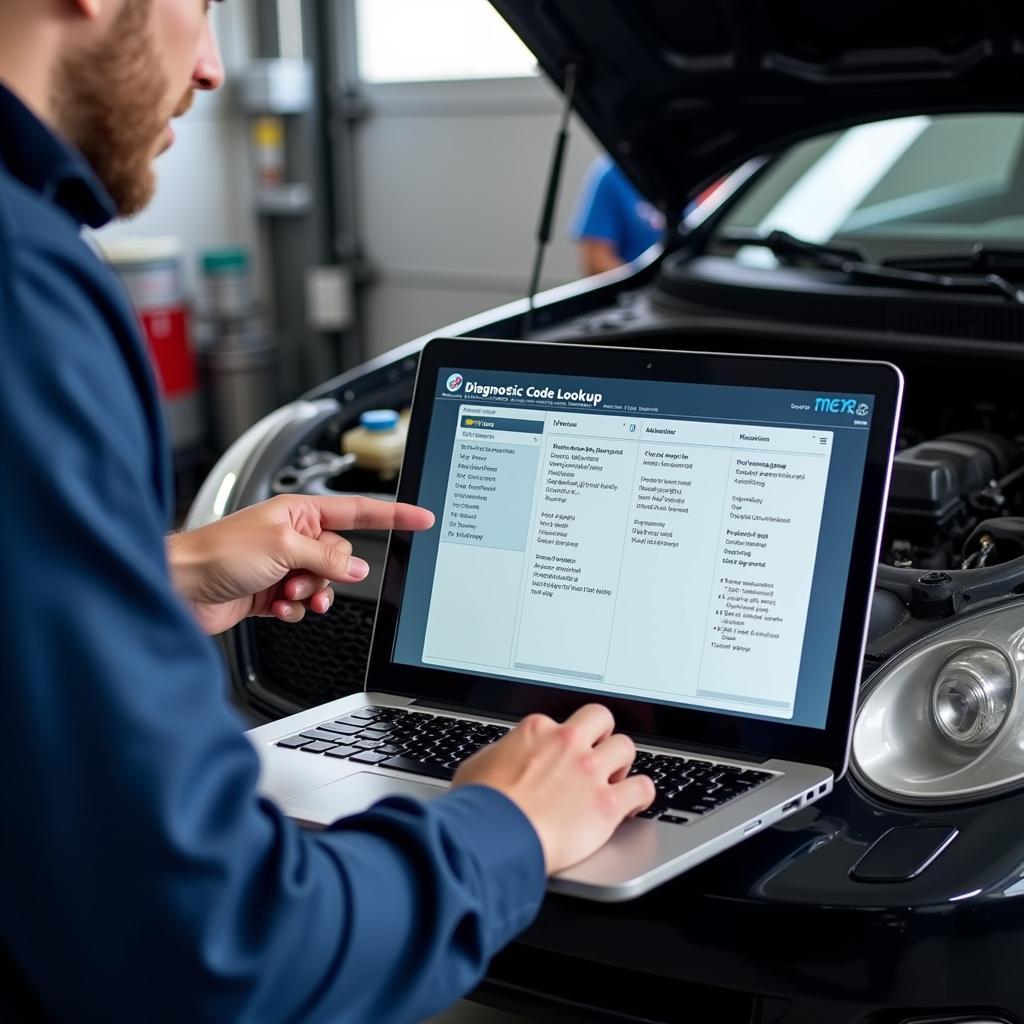Understanding car diagnostic codes is crucial for anyone who owns or works with vehicles. A Car Diagnostic Codes Lookup can save you time, money, and frustration by pinpointing the source of your car troubles. Whether you’re a seasoned mechanic or a DIY enthusiast, this guide will equip you with the knowledge you need to effectively interpret those cryptic codes and get your car back on the road.
Decoding the Mystery: What are Car Diagnostic Codes?
Car diagnostic codes, also known as Diagnostic Trouble Codes (DTCs), are alphanumeric codes that your car’s onboard computer (OBD-II system) generates when it detects a malfunction. Think of them as your car’s way of telling you something’s wrong. These codes provide valuable clues about the location and nature of the problem, enabling faster and more accurate diagnoses. You can access these codes through a car diagnostic weror reader or other compatible devices.
Did you know that most modern cars have standardized OBD-II systems? This allows for a car diagnostic code lookup across different makes and models, making diagnostics much simpler.
How to Perform a Car Diagnostic Codes Lookup
Performing a car diagnostic codes lookup is surprisingly straightforward. You’ll need an OBD-II scanner, which can range from basic code readers to advanced professional tools. Locate your car’s OBD-II port (usually under the dashboard on the driver’s side), plug in the scanner, turn on the ignition (without starting the engine), and follow the scanner’s instructions to retrieve the codes. Once you have the codes, you can use online resources or repair manuals to interpret their meaning.
 OBD-II Scanner Connected to Car
OBD-II Scanner Connected to Car
Understanding the Code Structure: What do the Letters and Numbers Mean?
Diagnostic Trouble Codes follow a specific structure. The first letter indicates the system where the fault is detected (e.g., “P” for Powertrain, “B” for Body, “C” for Chassis, “U” for Network). The following two numbers represent a more specific subsystem. The remaining digits indicate the specific fault within that subsystem.
Where to Find Reliable Car Diagnostic Code Information
Once you’ve retrieved the codes, you need to decipher their meaning. Several resources are available for car diagnostic code lookup, including online databases, repair manuals, and dedicated apps. DiagFixPro offers comprehensive information on bluetooth car diagnostic tools and resources for code interpretation.
What are some common places to find car diagnostic code information? Online databases, repair manuals, and dedicated mobile apps are all great resources.
Free vs. Paid Car Diagnostic Codes Lookup Resources
Both free and paid resources exist for car diagnostic codes lookup. Free resources can be a good starting point, but they may not always be comprehensive or up-to-date. Paid resources often offer more detailed information, including potential causes, diagnostic procedures, and repair solutions.
 Mechanic Using Diagnostic Software
Mechanic Using Diagnostic Software
Common Car Diagnostic Codes and Their Meanings
While thousands of diagnostic trouble codes exist, some are more common than others. For example, P0401 indicates an insufficient exhaust gas recirculation (EGR) flow, while P0171 suggests a lean air/fuel mixture. Understanding these common codes can give you a head start in diagnosing your car’s problems. You can also find specific information about diagnostic code reader diesel car.
Why is a car diagnostic download helpful? Having a downloadable resource readily available can be incredibly useful when you’re on the go and need to quickly look up a code.
“Accurate diagnosis is the cornerstone of effective car repair. Understanding diagnostic codes empowers car owners and mechanics to address issues efficiently, saving both time and money,” says John Smith, Automotive Engineer at DiagFixPro.
Car Diagnostic Codes Lookup: Beyond the Basics
While simply retrieving and interpreting codes can be helpful, taking a more holistic approach is crucial for accurate diagnosis. Consider factors like the car’s history, recent maintenance, and any accompanying symptoms. This information, combined with the diagnostic codes, provides a more complete picture of the problem.
“Don’t rely solely on the codes. Always consider the bigger picture, including the car’s history and any noticeable symptoms,” advises Maria Garcia, Certified Mechanic at DiagFixPro.
Conclusion: Mastering Car Diagnostic Codes Lookup
Performing a car diagnostic codes lookup is a valuable skill for any car owner or professional. By understanding how to retrieve, interpret, and contextualize these codes, you can save yourself time, money, and frustration. DiagFixPro offers a wealth of resources on car diagnostic download to help you navigate the world of car diagnostics and become a more informed car owner. Don’t let those cryptic codes intimidate you – empower yourself with the knowledge to take control of your car’s health.
FAQ
- What is an OBD-II scanner?
- Where can I find my car’s OBD-II port?
- How much does a car diagnostic code lookup cost?
- Can I perform a car diagnostic codes lookup myself?
- What are some common car diagnostic codes?
- What should I do after finding a diagnostic trouble code?
- Where can I find reliable information on car diagnostic codes?
Need help with your car diagnostics? Contact us via WhatsApp: +1(641)206-8880, or Email: [email protected]. Our 24/7 customer support team is ready to assist you.

Leave a Reply